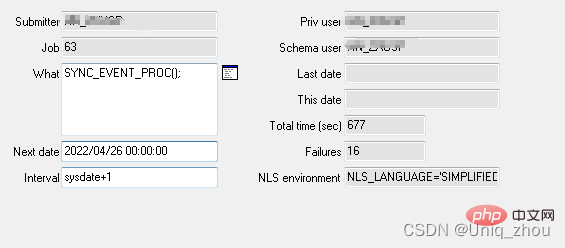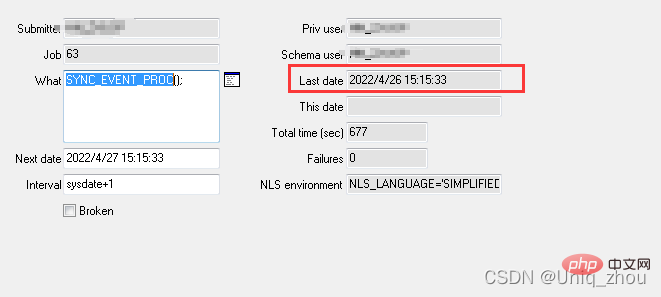 Database
Database
 Oracle
Oracle
 Analysis and solutions to the reasons why Oracle scheduled task timing is invalid
Analysis and solutions to the reasons why Oracle scheduled task timing is invalid
Analysis and solutions to the reasons why Oracle scheduled task timing is invalid
This article brings you relevant knowledge about Oracle. It is found that the system data has not been updated. Check the oracle scheduled task and it is estimated that it has not been executed. The following is an analysis of the reasons why the oracle scheduled task timing is invalid. and solutions, hope it helps everyone.

Recommended tutorial: "Oracle Video Tutorial"
Creating oracle scheduled tasks The scheduled tasks are not executed on time
Since the project needs to synchronize other system databases, after creating the dblink and stored procedures, a new dbm_job task was created. When I was fully expecting to get off work early, I found that the scheduled task was not executed according to the time.
Create a scheduled task JOB(63) The scheduled task is not executed

Cause analysis:
Maybe the database does not have the function of JOB Turn it on, so we lead in this direction to find a solution.
Solution:
After consulting the information, I found that there is a parameter job_queue_processes with a number of 0, which means that scheduled tasks will not be executed. The query SQL is as follows:
select value from v$parameter where name like '%job_queue_processes%';
Modify the parameter job_queue_processes Greater than 0, I set it here to 10 (you can increase it appropriately)
alter system set job_queue_processes =10;
Retest again:

Supplement: The parameter job_queue_processes seems to be a scheduled task queue process. I checked the information and added the following:
1. The value range of job_queue_processes is 0 to 1000. The total number of job processes that can be created is determined by the job_queue_processes parameter.
2. When job_queue_processes is greater than 1, and when jobs are executed in parallel, at least one is a coordinating process. The total number will not exceed the value of job_queue_processes.
3. The value of the job_queue_processes parameter is and DBMS_JOB is shared with DBMS_SCHEDULER.
4. Job_queue_processes parameter, when the value is set to 0, jobs created in any way will not run.
5. For non-zero value job_queue_processes, the number of job sub-processes depends on the available resources, resource configuration method and the number of currently running jobs.
6. In addition, the Scheduler jobs method is also limited by the setting of the scheduler attribute MAX_JOB_SLAVE_PROCESSES.
7. You can set max_job_slave_processes through DBMS_SCHEDULER.SET_SCHEDULER_ATTRIBUTE
Recommended tutorial: "Oracle Video Tutorial"
The above is the detailed content of Analysis and solutions to the reasons why Oracle scheduled task timing is invalid. For more information, please follow other related articles on the PHP Chinese website!

Hot AI Tools

Undresser.AI Undress
AI-powered app for creating realistic nude photos

AI Clothes Remover
Online AI tool for removing clothes from photos.

Undress AI Tool
Undress images for free

Clothoff.io
AI clothes remover

AI Hentai Generator
Generate AI Hentai for free.

Hot Article

Hot Tools

Notepad++7.3.1
Easy-to-use and free code editor

SublimeText3 Chinese version
Chinese version, very easy to use

Zend Studio 13.0.1
Powerful PHP integrated development environment

Dreamweaver CS6
Visual web development tools

SublimeText3 Mac version
God-level code editing software (SublimeText3)

Hot Topics
 1378
1378
 52
52
 How to check tablespace size of oracle
Apr 11, 2025 pm 08:15 PM
How to check tablespace size of oracle
Apr 11, 2025 pm 08:15 PM
To query the Oracle tablespace size, follow the following steps: Determine the tablespace name by running the query: SELECT tablespace_name FROM dba_tablespaces; Query the tablespace size by running the query: SELECT sum(bytes) AS total_size, sum(bytes_free) AS available_space, sum(bytes) - sum(bytes_free) AS used_space FROM dba_data_files WHERE tablespace_
 How to import oracle database
Apr 11, 2025 pm 08:06 PM
How to import oracle database
Apr 11, 2025 pm 08:06 PM
Data import method: 1. Use the SQLLoader utility: prepare data files, create control files, and run SQLLoader; 2. Use the IMP/EXP tool: export data, import data. Tip: 1. Recommended SQL*Loader for big data sets; 2. The target table should exist and the column definition matches; 3. After importing, data integrity needs to be verified.
 How to encrypt oracle view
Apr 11, 2025 pm 08:30 PM
How to encrypt oracle view
Apr 11, 2025 pm 08:30 PM
Oracle View Encryption allows you to encrypt data in the view, thereby enhancing the security of sensitive information. The steps include: 1) creating the master encryption key (MEk); 2) creating an encrypted view, specifying the view and MEk to be encrypted; 3) authorizing users to access the encrypted view. How encrypted views work: When a user querys for an encrypted view, Oracle uses MEk to decrypt data, ensuring that only authorized users can access readable data.
 How to create a table in oracle
Apr 11, 2025 pm 08:00 PM
How to create a table in oracle
Apr 11, 2025 pm 08:00 PM
Creating an Oracle table involves the following steps: Use the CREATE TABLE syntax to specify table names, column names, data types, constraints, and default values. The table name should be concise and descriptive, and should not exceed 30 characters. The column name should be descriptive, and the data type specifies the data type stored in the column. The NOT NULL constraint ensures that null values are not allowed in the column, and the DEFAULT clause specifies the default values for the column. PRIMARY KEY Constraints to identify the unique record of the table. FOREIGN KEY constraint specifies that the column in the table refers to the primary key in another table. See the creation of the sample table students, which contains primary keys, unique constraints, and default values.
 How to view instance name of oracle
Apr 11, 2025 pm 08:18 PM
How to view instance name of oracle
Apr 11, 2025 pm 08:18 PM
There are three ways to view instance names in Oracle: use the "sqlplus" and "select instance_name from v$instance;" commands on the command line. Use the "show instance_name;" command in SQL*Plus. Check environment variables (ORACLE_SID on Linux) through the operating system's Task Manager, Oracle Enterprise Manager, or through the operating system.
 How to uninstall Oracle installation failed
Apr 11, 2025 pm 08:24 PM
How to uninstall Oracle installation failed
Apr 11, 2025 pm 08:24 PM
Uninstall method for Oracle installation failure: Close Oracle service, delete Oracle program files and registry keys, uninstall Oracle environment variables, and restart the computer. If the uninstall fails, you can uninstall manually using the Oracle Universal Uninstall Tool.
 How to get time in oracle
Apr 11, 2025 pm 08:09 PM
How to get time in oracle
Apr 11, 2025 pm 08:09 PM
There are the following methods to get time in Oracle: CURRENT_TIMESTAMP: Returns the current system time, accurate to seconds. SYSTIMESTAMP: More accurate than CURRENT_TIMESTAMP, to nanoseconds. SYSDATE: Returns the current system date, excluding the time part. TO_CHAR(SYSDATE, 'YYY-MM-DD HH24:MI:SS'): Converts the current system date and time to a specific format. EXTRACT: Extracts a specific part from a time value, such as a year, month, or hour.
 How to read the oracle awr report
Apr 11, 2025 pm 09:45 PM
How to read the oracle awr report
Apr 11, 2025 pm 09:45 PM
An AWR report is a report that displays database performance and activity snapshots. The interpretation steps include: identifying the date and time of the activity snapshot. View an overview of activities and resource consumption. Analyze session activities to find session types, resource consumption, and waiting events. Find potential performance bottlenecks such as slow SQL statements, resource contention, and I/O issues. View waiting events, identify and resolve them for performance. Analyze latch and memory usage patterns to identify memory issues that are causing performance issues.



